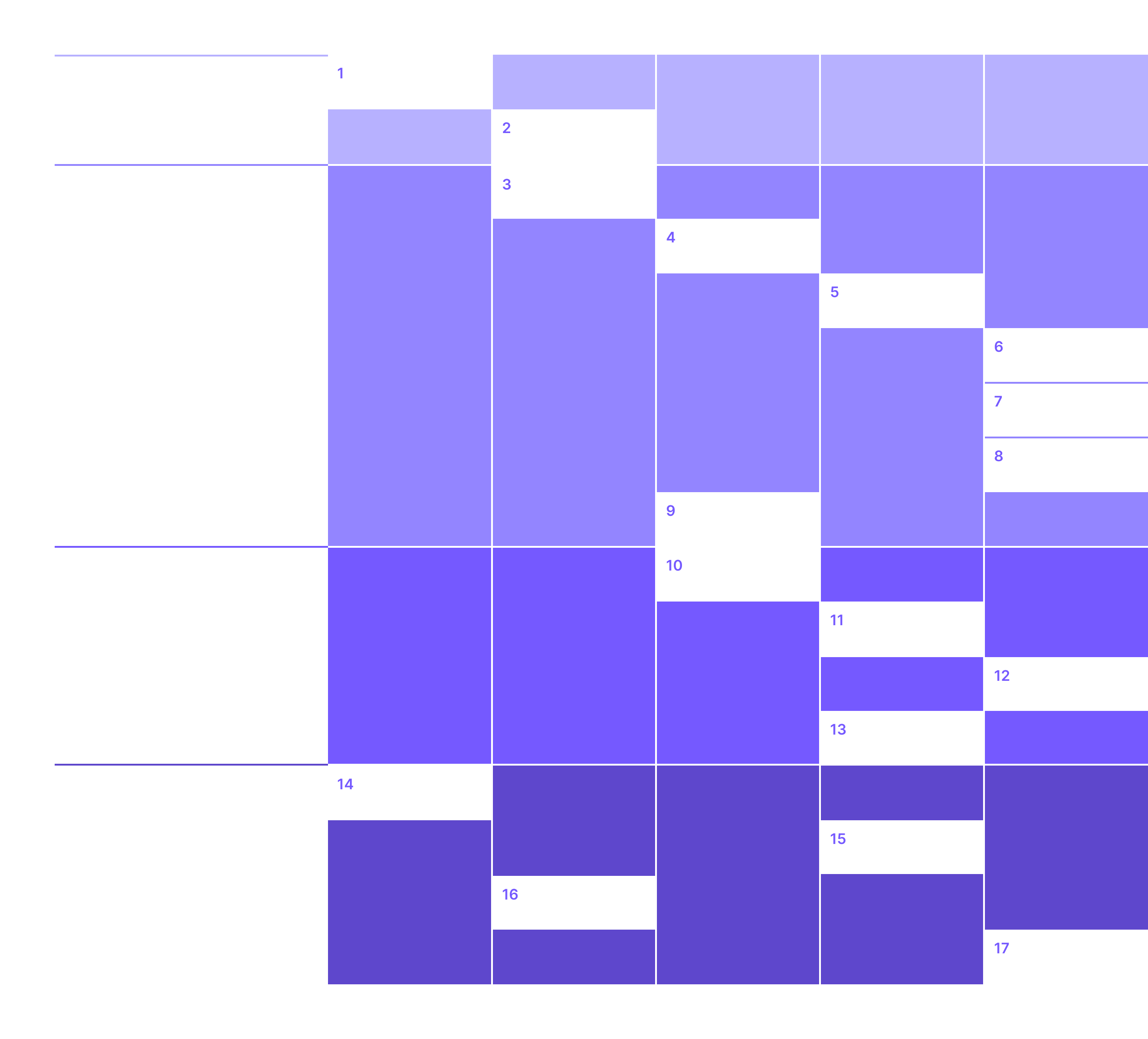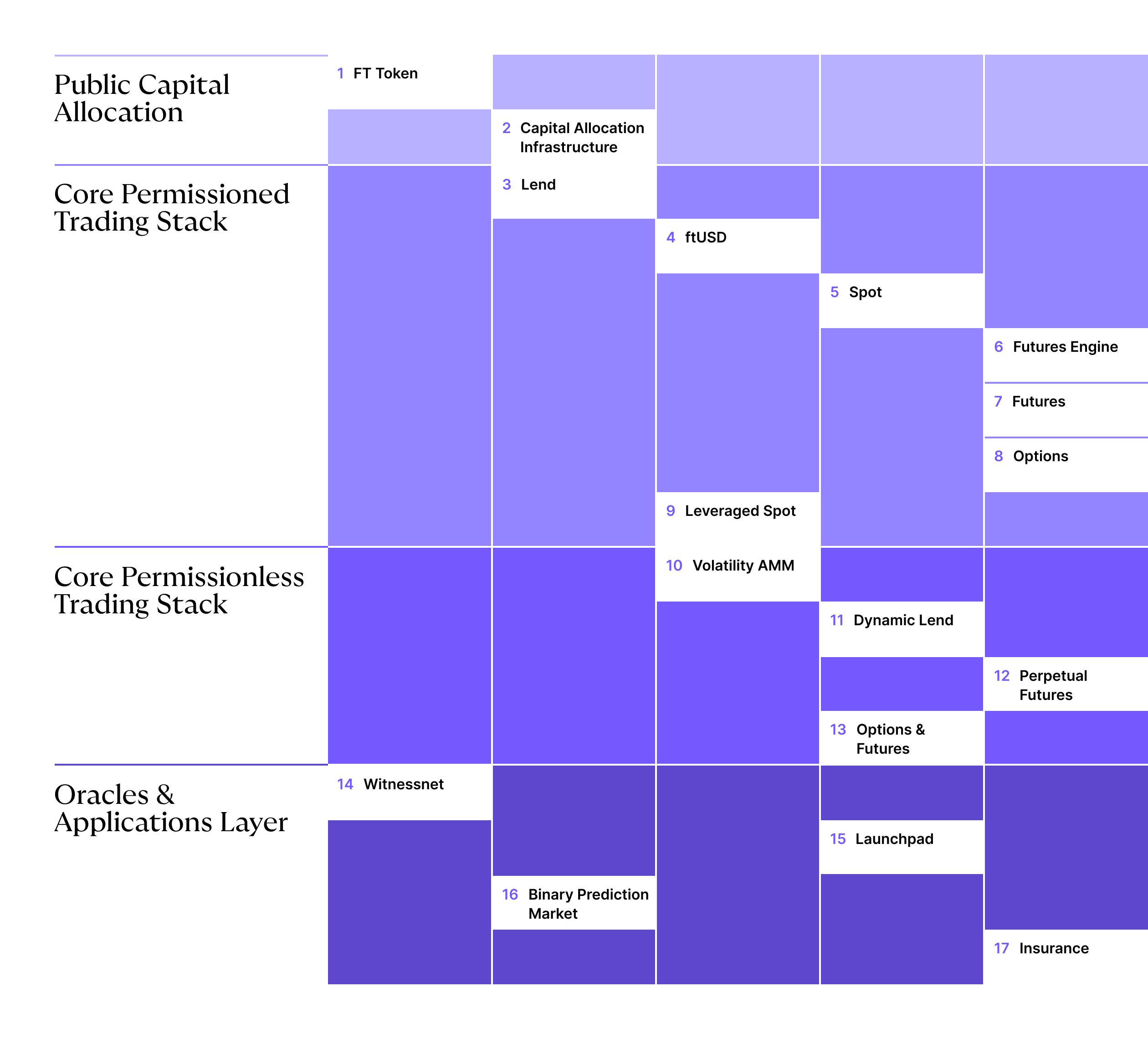Roadmap
Development Cycle
Flying Tulip's releases adhere to the following development cycle:
- Internal Development: codebase is rapidly changed with ongoing audits.
- Code Freeze: codebase is finalized.
- Independent Comprehensive Review: codebase pass through at least 3 independent audits.
- Go-to-market Preparation: codebase is shaped as a product.
- Release: product reaches users.
Advance to a downstream item happens only when upstream dependencies are stable and audited. This creates a waterfall path rather than hard calendar promises. Detailed breakdown and sequencing reflect those dependencies in the next sections.
Milestones
Milestones execution and dependencies can be described by the following diagram:
Note: Each block is a fully-working product released independently. FT starts working as soon as the first product block is released, and each block expands the number of services FT offers.


Right‑side items have a hard dependency on the left‑side items, e.g., CLOB depends on ftUSD. Top items are executed first. Bottom items start only after the complete cycle for the item above it is finished. Numbers next to product names show delivery order, so 1 comes before 2.
Note: In the following sections, product mentions match their planned delivery order.
1. Public Capital Allocation
An on‑chain raise where FT token is minted as capital gets allocated. Capital Allocation comes together with on‑chain Perpetual PUT Option. This step lays a foundation for a token‑first model and funds future development while preserving capital in conservative, liquid strategies.
2. Core Permissioned Trading Stack
Permissioned release of core Flying Tulip products. This step demonstrates protocol mechanics under tighter controls and completes the audit cycle before expanding surface area. "Permissioned" in this case refers to capped deposits, guarded launches and approved asset lists.
- Lend: Cross‑collateral pool that backs CLOB orders and Futures while deposits continue to earn.
- ftUSD: Dollar‑target settlement rail that enables Futures, trading, and collateral.
- Leveraged Spot: Comes with dependency on Lend.
- Spot: Price source and execution venue that feeds time and reserve‑weighted windows to downstream systems.
- Perpetual Futures: Oracleless perpetual futures engine that settles to internal trading.
- Futures and Options: Sequenced after perpetual Futures once the stack is stable.
3. Core Permissionless Trading Stack
Open access to Flying Tulip core which is mature and audited. Lift of "permissions" introduced in previous step. Core Stack surfaces the same mechanics with market‑driven discovery and broader listings.
- Volatility‑adaptive AMM: An adaptive curve shifts between constant‑sum and constant‑product based on implied volatility and emits depth‑aware windows used across Lend and Futures. See the Spot page.
- Dynamic Lend: Every AMM pair exposes a lending market automatically. LTVs and liquidations remain depth‑aware.
- Permissionless Futures and Options: Depth‑aware internal pricing extends to a wider set of markets. Futures settle in ftUSD.
4. Oracles & Applications Layer��
Proven pricing and settlement stack powers ecosystem apps and integrations.
- Witnessnet: Brings oracleless proofs for on‑chain verification of HTTPS data without third‑party oracles.
- Binary prediction markets: Resolve to facts proven via Witnessnet from accepted domains such as CoinDesk and CoinTelegraph. Anyone can submit a proof to resolve a Yes or No question.
- Launchpad: Token creation flow with threshold‑based launches and auto‑deployed AMM plus a money market. The initial launch window has anti‑MEV protections. Leverage and futures unlock after an RWAP warm‑up.
- Insurance: Provides pay‑as‑you‑go protection that behaves like a lending market, integrates with Lend for cross‑collateral, and uses AMM and CLOB context for risk.
With the whole product vertical set, protocol revenue flows into FT buyback-and-burn's reinforcing the token‑first model.
Timeline Expectations
Note: Each block is a fully-working product released independently. FT starts working as soon as the first product block is released, and each block expands the number of services FT offers.
Assuming each stage including development, freeze, audit, and launch preparation averages 2 to 3 months, the full roadmap spans roughly 36 to 54 months (3 to 4.5 years), with downstream items beginning only after upstream milestones pass audits.
Brief Summaries
The following products/features either lack their own documentation pages or include additional context here. Brief summaries are provided for clarity:
- Witnessnet accepts
(url, response, proof)and validates AEAD‑authenticated TLS records, key derivation to traffic keys, finished verification, and certificate and hostname binding through CertificateVerify. Any HTTPS endpoint becomes an implicit oracle. - Launchpad is a simple token‑launch workflow with liquidity thresholding and staged unlocks for leverage and futures after an RWAP warm‑up.
- Binary Prediction Markets are "Yes" or "No" markets resolved permissionlessly via Witnessnet proofs from approved domains. Accepted sources are configured per market.
- Volatility‑Adaptive AMM provides an adaptive curve that transitions between constant‑sum and constant‑product based on implied volatility with smoothing through EMAs and bounded shifts. It emits TWAP, RWAP, TWAR, and RVOL windows and supports concentrated and leveraged liquidity. See the AMM page.
- Options run on on‑chain Black–Scholes model with implied volatility from AMM windows. They support covered call and put writing and later IV‑informed pricing.
- The Cross‑Margin permissioned venue is an institution‑oriented stack with reporting and OFAC controls. Deposits can back CLOB orders, futures, and options under one risk engine.
- Session Keys and Wallet Abstraction provide Passkey and WebAuthn sign‑in and delegated session keys for seamless UX. State channels enable continuous trading while withdrawals remain on‑chain gated.